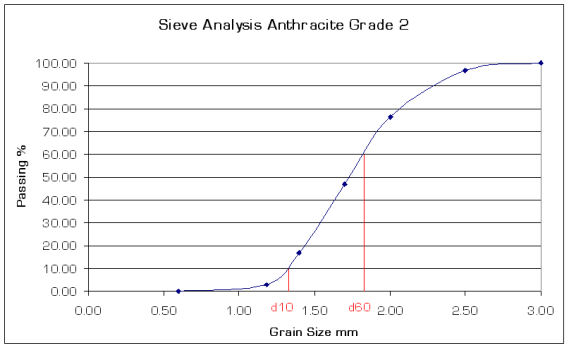
media specification
Filter Media is specified by its grain size distribution. This is based
upon a Sieve Analysis.

| Equipment required for sieve analysis 1. Vibrating table 2. Stack of sieves 3. Calibrated scales |
| Example | Anthracite Filter Media | |||
| Grade 2 [1.18 - 2.50] | ||||
|
Sample 132 grams |
||||
| Sieve | Retained | Retained | Retained | Passing |
| mm | grams | % | acc % | acc% |
| 2.50 | 4.1 | 3.1 | 3.1 | 96.9 |
| 2.00 | 26.9 | 20.4 | 23.5 | 76.5 |
| 1.70 | 39.1 | 29.6 | 53.1 | 46.9 |
| 1.40 | 39.7 | 30.1 | 83.2 | 16.8 |
| 1.18 | 18.2 | 13.8 | 97.0 | 3.0 |
| Tray | 4.0 | 3.0 | 100.0 | 0.0 |
| 132.0 | 100.0 | |||
The result of the sieve analysis is plotted on a graph and a curve
drawn between the points [AWWA B100-01]

From the graph the specification of the filter media may be determined
| Specification | . | Example | Comments |
| Top Size | d95 | 2.50 mm | Specification for grade 2 Anthracite |
| Bottom Size | d5 | 1.18 mm | Specification for grade 2 Anthracite |
| Over Size | . | 3.10% | Maximum 5% oversize allowed |
| Under Size | . | 3.00% | Maximum of 5% undersize allowed |
| Effective Size | d10 | 1.33 mm | 10% of the grains passing this size |
| Uniformity Coefficient | . | 1.37 | Ratio of d60 divided by d10 [Max 1.50] |
| Hydraulic Size | . | 1.67 mm | See Hydraulic Size page |
| Minimum Size | d1 | 0.95 mm | 1% passing. Criteria not in common use |
| Size Ratio | . | 2.12 | d95 divided by d5 |
| . | d60 | 1.83 mm | Used to calculate uniformity coefficient |
There are two ways to specify filter media [AWWA B100-01]
1 Top size,
bottom size, over size and under size
2 Effective
size and uniformity coefficient
Unfortunately far too many customers try to specify filter media using
as many criteria as possible which, often as not, means that it is then
impossible to produce. It is also strongly advisable to specify a media
that is in common use with a standard specification.